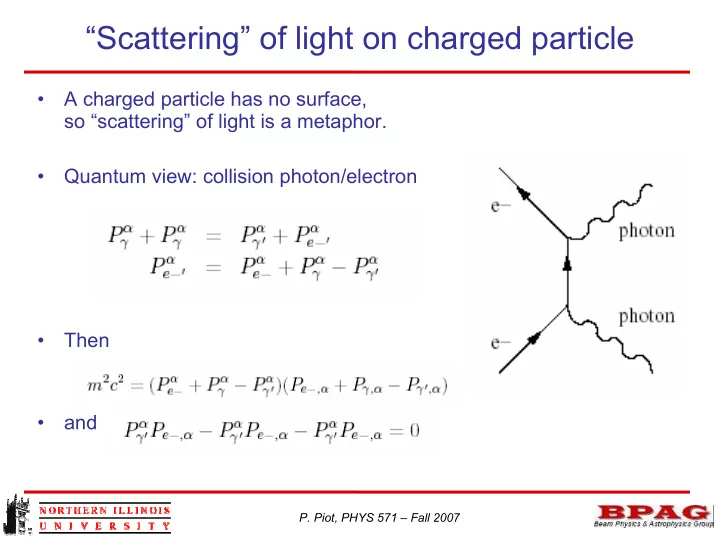

“Scattering” of light on charged particle • A charged particle has no surface, so “scattering” of light is a metaphor. • Quantum view: collision photon/electron • Then • and P. Piot, PHYS 571 – Fall 2007
“Scattering” of light on charged particle • We have Taking and similarly for γ ’, we have • this is the usual Compton scattering formula. The non-relativistic limit yields λ=λ ’ , which is the regime of Thomson scattering P. Piot, PHYS 571 – Fall 2007
Linear Thomson Scattering: cross section I • Cross section in a figure-of-merit. • Since the electron is at rest: where acceleration • So finally P. Piot, PHYS 571 – Fall 2007
Linear Thomson Scattering: cross section II • Note that in the non-relativistic limit • Let’s now specialize our problem and consider a plane wave: • The acceleration is therefore given by: • We ignore the B-field associated to the plane wave because we assume β =0 P. Piot, PHYS 571 – Fall 2007
Linear Thomson Scattering: cross section III • Given the geometry of the problem we have • Thus • So the time averaging gives P. Piot, PHYS 571 – Fall 2007
Linear Thomson Scattering: cross section IV • Assume the incoming wave is unpolarized then • So • So finally • The Poynting vector is given by P. Piot, PHYS 571 – Fall 2007
Linear Thomson Scattering: cross section V • The time averaged power per unit of area is • And so the cross-section is this is the scattering Thomson cross section. The integrated cross section is: P. Piot, PHYS 571 – Fall 2007
Notes on Nonlinear Thomson Scattering I • Classical Thomson scattering, the scattering of low-intensity light by e-, is a linear process: it does not change the frequency of the radiation; • The magnetic-field component of light is not involved. • But if the light intensity is extremely high (~10 18 W.cm -2 ), the electrons oscillate during the scattering process with velocities appro- aching c . • In this relativistic regime, the effect of the magnetic and electric fields on the electron motion should become comparable P. Piot, PHYS 571 – Fall 2007
Notes on Nonlinear Thomson Scattering II • First experimentally observed in 1998 Nature 396 issue of Dec. 17 th , 1998 3 rd harmonic patterns 2 nd harmonic patterns P. Piot, PHYS 571 – Fall 2007
Case of a bounded electron I • Compton and Thomson scatterings apply to free electrons • What happen if an electron is bounded (i.e. to an atom)? • We assume the equation of motion of the bounded electron to be described by: external force acceleration restoring force friction term • As before we take and then P. Piot, PHYS 571 – Fall 2007
Case of a bounded electron II We further assume that i.e. |x|<< λ . • • then • so • And finally • Same as before but the denominator is different P. Piot, PHYS 571 – Fall 2007
Case of a bounded electron III • The radiated power is therefore • and the associated cross section is ω<<ω 0 and ω<<Γ corresponds to Thomson scattering • ω<<ω 0 and ω>>Γ gives the Raleigh scattering cross section • The reason why the sky is blue… P. Piot, PHYS 571 – Fall 2007
Recommend
More recommend